Social media seems to be stirring up fear that sunscreen is more than harmful than beneficial, without legitimate studies to support this fear mongering. One study fed rats a ridiculous amount of sunscreen and it caused trouble, but all of the human testing we’ve seen, through sources we consider authoritative including the CDC and FDA, agree on two key points: that a risk to humans has not been established for US-approved sunscreen ingredients, and the risk of skin cancer certainly has. I have observed that practically all mature sailors I know have had a cancerous spot removed. And then there is the matter of “reef safe” formulations, which we’ve found to be unsupported for sailors. If you have a few minutes, plead follow us on another trip down the rabbit hole.
This report examines the intricacies of making a sound sunscreen choice. But we have concluded many of the available products will get the job done. Here are some key takeaways. And if you want to take a deeper dive, we offer a more detailed perspective.
Rather than nitpick over which sunscreen is best, focus on the basics:
- SPF 40 or greater.
- Comfortable enough that you will use it.
- Cheap enough that you will use enough.
- Easy enough to apply.
- Water resistant enough for your activity.
- Reapply every two hours.

Covering up will always be the gold standard. On the boat, hard tops and Biminis are wonderful. Wide brims, full coverage sunglasses, and long sleeve wicking shirts will reduce sunscreen use. Use sunscreen on exposed areas of the neck, lips (sticks are good for touching up), nose and lower face, ears, and tops of feet if you like sandals. Apply 20 minutes before going out; it needs time to soak in, it’s easy to get caught up in sailing and forget, and it’s hard to apply on sweaty skin anyway. We avoid sunscreen above the eyes if there is spray or sweat; sunscreen in the eye stings and can be unsafe if you cannot see clearly at the wrong moment. But you need a good brim and wrap-around glasses.
Wash your hands before touching clear vinyl windows; it can leave a permanent handprint.
In the water, continue to cover up. Just bobbing to cool off? Consider the shady side of the boat or under the bridge deck or tramp of a multihull. Wear a rash guard when swimming and a hat if you will be staying on the surface; clothes don’t wash off. As long as the fabric does not go practically transparent when wet, it’s blocking UV. Shoulders, back, and face are the risk areas.
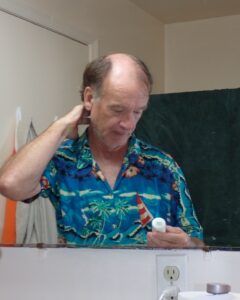
Arms and legs are shielded to some extent by the water; by reflection off the surface, because they are under you and either in the shade or at a much lesser angle to the sun, and because the sunlight refracted (bent) when it enters the water and strikes the legs at a lower angle. The only burns I remember when in the water were snorkeling or surfing, where the back, shoulders, and back of the legs (snorkeling) are vulnerable. Avoiding mid-day is also wise, even more than on land; the lower the angle, the more light reflects (chop and waves increase effect).
NOTES FROM THE TEST BENCH
Ingredients. Because of concerns about reef bleaching, all of the leading brands of sunscreen we investigated (see link to product chart here) have reformulated around the most troubling ingredients. Avobenzone is perhaps the most common ingredient, and for good reason. It is one of few ingredients that provide broad spectrum protection—UVA (315–400 nm), UVB (280–315 nm). However, it is not a concern for reefs until 3-4 parts per million (ppm), which is much higher than ingredients of concern and many times higher than what has been measured at even at the most crowded, poorly flushed shoulder-to-shoulder tourist beaches. Its primary weakness is that it is not photostable and degrades in the sunlight, losing as much as 36% of its UV-absorption capacity after just one hour of sunlight. This can be reduced through the use of stabilizing agents. Yes, this is one of the reasons why sunscreens must be reapplied every few hours, but sunscreen is also sweated off and rubbed off by collars and hair and everything we touch.
Mineral sunscreens like zince, which rub in and become invisible reflect only about 3-5% of the UV. If they were reflecting any more you would look like Casper the Ghost. The same goes for opaque sun blocks. The rest is dissipated as heat within the skin. When the zinc particles wash off they dissolve in water, exhibiting toxicity towards barnacles and coral at about 1 ppm, exactly the same as zinc ions from any source, including zinc-based antifouling paint and anodes. Titanium dioxide (0.1 PPM threshold) works differently, creating free radicals through reaction with sunlight.(Our testing TiO2-based photoreactive paints showed them to be less effective than copper or zinc.)
Endrocrine disruption. The only studies we could find involved feeding rats oxybenzone an amount in a matter of a few days that would take 277 years of sunscreen use to achieve. Also consider that sunscreen chemicals are, by their inherent nature, unstable, (they react with UV and break down as a method of blocking UV) and quickly break down in the environment. Out of an abundance of caution, in 2019 the FDA commissioned further testing on a list of 12 ingredients. (Not yet concluded—see interim report here.
Nano Particles (defined as 1-100 nanometres or nm). Titanium dioxide pigments used in paints and food colorings are typically 200-300 nm. Zinc oxide, when used as a pigment or white sunblock, has particles of 1000-2000 nm. However, if the particles are sufficiently small, typically 1-50 nm, they interact with visible light (400-700 nm) less and become less visible, while still interacting with the shorter wavelengths of UV light (100-400 nm). Opaque mineral sunblocks do not contain nano particles, while invisible mineral sunscreens do. Are the nano particles in mineral sunscreens safe? In terms of the environment they are not that different from organic sunscreens. Titanium dioxide nano particles are listed as probably carcinogenic if ingested or inhaled (animal testing only), so we would rule out powdered sunscreens and keep titanium sunscreens away from our lips, but there is no evidence of risk when applied to the skin, and there has been lots of industry exposure over 70 years in the pigments industry to support this. In the body, traces of zinc function as a micro nutrient and you can buy zinc pills. All things considered, we recommend zinc if you decide to go the mineral sunscreen route.

Reef Safe. In 2021, Hawaii banned sunscreens containing the chemical active ingredients oxybenzone and octinoxate because studies have shown these chemicals to have harmful impacts on the marine environment and ecosystems, including coral reefs. First, although many leading products used to contain the banned ingredients, all of the samples we tested and all those we researched have been reformulated without them. Even those not labeled “reef safe” or “reef friendly” are nearly always reef safe to this extent; we could find none that were not. As often happens, if just a few states or areas ban an ingredient, manufactures reformulate nationwide to avoid marketing and distribution problems. Check specifics if you are going to an area where ingredients are regulated—the reef-safe label does not guarantee compliance in a few areas with more strict rules. See table 1 for a list of substances that have been found potentially harmful or that are in question. See table 2 for a list of reef safe ingredients. A few ingredients are on both lists.
Notice the levels required to cause coral bleaching. Though a few ppm seems low, in fact, it is quite a lot when dilution is considered. Assume you apply the recommended 30 grams (1-ounce), and most people apply far less (one third), and that 25% of it washes off (typical water resistance test result). The concentration of the potentially harmful ingredient is typically 2-3%, so that is about 0.06 grams. A bathtub (EPA figure) holds 70 gallons, or 26,500 grams, creating a 2 ppm solution, barely over the threshold. In fact, levels approaching 1 ppm have been measured in a few poorly flushed, shoulder-to-shoulder resort beaches where the water quality is dubious for many reasons. Any place you would actually anchor, the concentration will be non-detectable. Similar logic holds with zinc sunscreens. In this case we are comparing the tenth of a gram that will wash off with the 5,000-10,000 grams of copper and zinc in your bottom paint and a few hundred more grams in anodes (about half of this ends up in the water, based on testing of sanding dust from boat bottom preparation and weighing used anodes). Your sunscreen contribution is equivalent to swimming more than 100 times every day, all year. Not likely, and you could save your sunscreen contribution by stretching your time between antifouling by a week. And barnacles aren’t skin cancer.
In fact, the Australian environmental authorities have correlated every mass coral bleach event to high water temperatures. In my limited diving experience, coral bleaching was seen primarily around sewer and stormwater outfalls. The reef problems are runoff, pH drop, and climate change. So why were the ingredients banned? An abundance of caution is a good thing, but the obvious reason is to create the appearance of doing their jobs with minimal negative blow back. Controlling runoff and sewage treatment is expensive, climate change is beyond the influence of local authorities, but they can ban a few products, and through this action, perhaps by this, attract more tourists. Political realities in practice.
Water Resistance (test method described in 21 CFR 201.327(i)(7)]). To claim water resistance, the sunscreen must meet the stated SPF after 40-80 minutes of moderate activity (not defined) in the water. This does not include towel drying, so you will need to reapply. It does not include friction with clothes around the collar line, and there is no standard for sweat resistance. Applying a water resistant sunscreen over sweaty skin seems like a questionable exercise, since it struggles to soak in when you are pumping sweat. Apply sunscreen 20 minutes ahead of time so that it can soak in and reapply in the shade only after you have cooled down. I apply it ahead mostly so I don’t forget once I get on the boat!
Broad spectrum. This claim is regulated by the FDA and insures that both UVA and UVB rays are screened. Some products designed to encourage tanning primarily screen out UVB, and while they will reduce sunburn, they will not protect you from UVA, which is the greater skin cancer and aging concern. Tanning is just damage and aging. Zinc sunscreens are somewhat more effective in blocking UVA rays.
Minimum SPF of 40. An SPF twice as high does not give double the protection because of wearing off and uneven application; for example, SPF 70 sunscreen that is applied lightly or not reapplied at the same two hour interval, will not give the same protection as proper application of SPF 35. Don’t rely on makeup (foundation) as sunscreen; the products are typically no more than SPF 15, and it’s unlikely you are applying it over all areas, applying enough, and reapplying often enough. SPF 40 is our recommended minimum, and expect to use ½- to 1-ounce each time, depending on the amount applied. A bottle should not last for years!
Testing. We looked at a lot of tests by independent reviewers and found results that were all over the place, even for products with the same SPF. This was strikingly similar to our personal experiences with mosquito repellants, which we have tested, and sunscreen through the years. Skin is extremely variable. Some people absorb quickly and deeply, some don’t, so application can vary. Some people burn easily (or attract mosquitoes) and some don’t. And in both cases—DEET for mosquito repellants and most often avobenzone for sunscreens—there is only one significant active ingredient, and yet different testers report very different results. Unless you are prepared to use 10 test subjects (FDA method) and exacting methods, the results will be inaccurate. You are better off just accepting the SPF ratings based on FDA test methods. In the case of mosquito repellant, look for about 15% DEET; less and it won’t last or will require a lot; more is just wasted and increases systemic absorption. In the case of sunscreens, if there is 4-5% avobenzone and octocrylene combined, or 7-10% zinc and titanium combined, the SPF will be 30-50 and it will work fine. Again, more is just wasted.
Spray vs. Lotion vs. Stick. Sprays perform quite well in testing, if you apply the recommended amount (about one ounce for total body), and that means really laying it on, not just a light mist as you would with bug spray. For comparison, spray paint is applied at about 3 square feet per coat per ounce, and your body is about 5-7 square feet exposed. We’re not fans on a boat because you can’t control where the spray goes and it can damage vinyl windows and cushions. Save sprays for the beach and apply downwind of others. High SPF sticks for the lips and nose are smart, since they encourage frequent reapplication and these are extremely vulnerable areas.
Mineral sunscreens, including those that are labeled invisible, may not disappear completely on those with darker complexions.
Even the ultimate sunscreen rubs off. Small wonder the collars of my wicking shirts are stained. Also wrists, ears, anywhere hair rubs, and against any objects you touch in your activities.
NON-US BRANDS
What about the buzz that European sunscreens are more effective, using new ingredients that are more effective at screening UVA rays than avobnezone and longer lasting? In the US, sunscreens are regulated the same as over-the-counter medication, and as a result of the complexity of the approval process, no new ingredients have been approved since 1996. It is illegal to sell or for consumers to buy non-FDA approved sunscreen in the US. We’re not going to unpack whether that makes sense and we’re not going to recommend products that are not legal for sale or purchase in the US. That said, there is rumor that one or several of the new ingredients may be approved in 2025, so we’ll be keeping an eye on that. We also believe that the noisiest press contains considerable exaggeration, and we have learned that many of the US formulations do meet European standards. There is always a buzz that the grass is greener somewhere else, and there have been many disasters when a drug was rushed to market, only to learn that the long-terms effects might outweigh the benefits. It’s seldom as simple as the news.
There is also buzz that Japanese and Asian sunscreens are less greasy and more pleasant to wear, and that Aussy sunscreens can be unpleasant. The reason is that Australians have the most strict water resistance standards and Japan standards are among the most lenient, since swimming is everything in Australia, and not so much in Japan. The Aussies measure SFP after 90 minutes of water exposure, the Japanese standard allows up to 70% decline after water exposure without affecting the rating, and the US falls allows choosing 80 minutes or a lesser 40 minutes water exposure before testing (the time period is required to be on the bottle—look for it).
SUMMARY
Health Concerns. Other than the rare skin allergy, we could find no credible study suggesting that there is endocrine disruption or cancer risk associated with modern sunscreen formulations, and there have been lots of studies.
Both mineral and organic sunscreens offer comparable UVA and UVB protection if applied at the recommended rate. Mineral sunscreens do not degrade in the sun but seem to wash off a bit faster due to sweat, clothing friction, and swimming (our impression—we could see them come to the surface and wipe off). The result is similar SPF ratings.
Reef Safe. There is no regulatory definition of the term, only a few studies and a few areas that have banned certain ingredients. Mineral sunscreens often make this claim, but the data don’t support that zinc and titanium are safer than the new organic sunscreens. All of the major brand products we looked at, including those not labeled as “reef safe,” have formulated away from oxybenzone, octinoxate, and PABA (the chemicals most likely to harm reefs). Furthermore, in the areas where sailors are likely to swim from their boats there is zero risk of reaching concentrations within 100 times of the risk level. As for zinc, release from sunscreen is thousands of times less than that from a zinc-based antifouling, which has been studied.
The Bottom Line: Skin Cancer is real. I don’t know a mature sailor that has not had a few spots removed, and I know people that died from skin cancer.
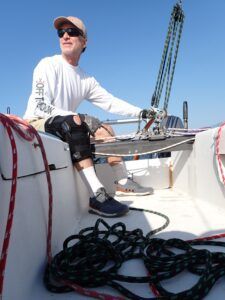
This piece ran in the April, 2009 issue of Practical Sailor and has been updated.



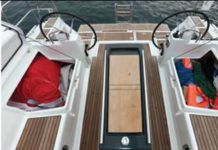















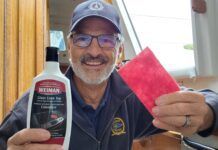








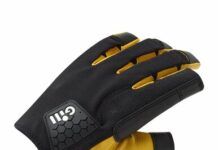


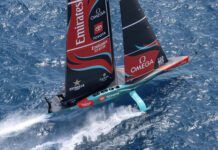



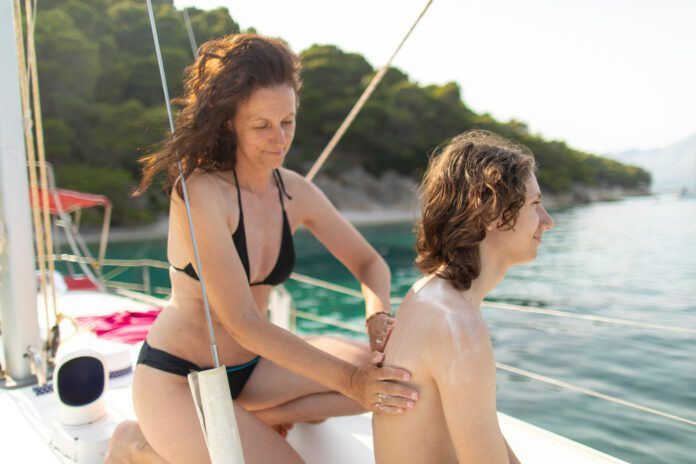







Spray sunscreens leave a semi-permanant stain on gelcoats (orangey-brownish) that only time and sunshine diminish. It is the bane of my existence as a charter boat owner/operator. I have found no product that removes the stain. Acids and bleaches diminish it but are hell on the wax and gelcoat. The sprays should be banned. I’d love for practical sailor to investigate.
Re. Sprays, agreed. Our advise is to keep them off the boat.
Spray mosquito repellents (DEET) are and even more severe hazard to plastics, and specifically vinyl windows. Unfortunately, they are harder to avoid. We recommend applying well downwind and washing your hands after applying. Washing hands is vital after using either sunscreen or DEET, before touching vinyl windows.